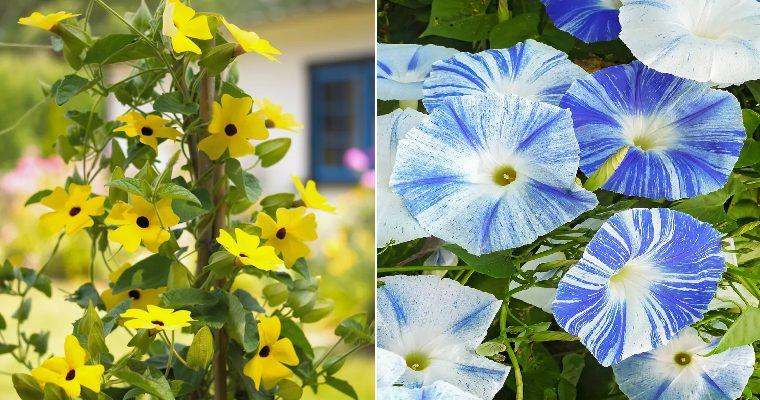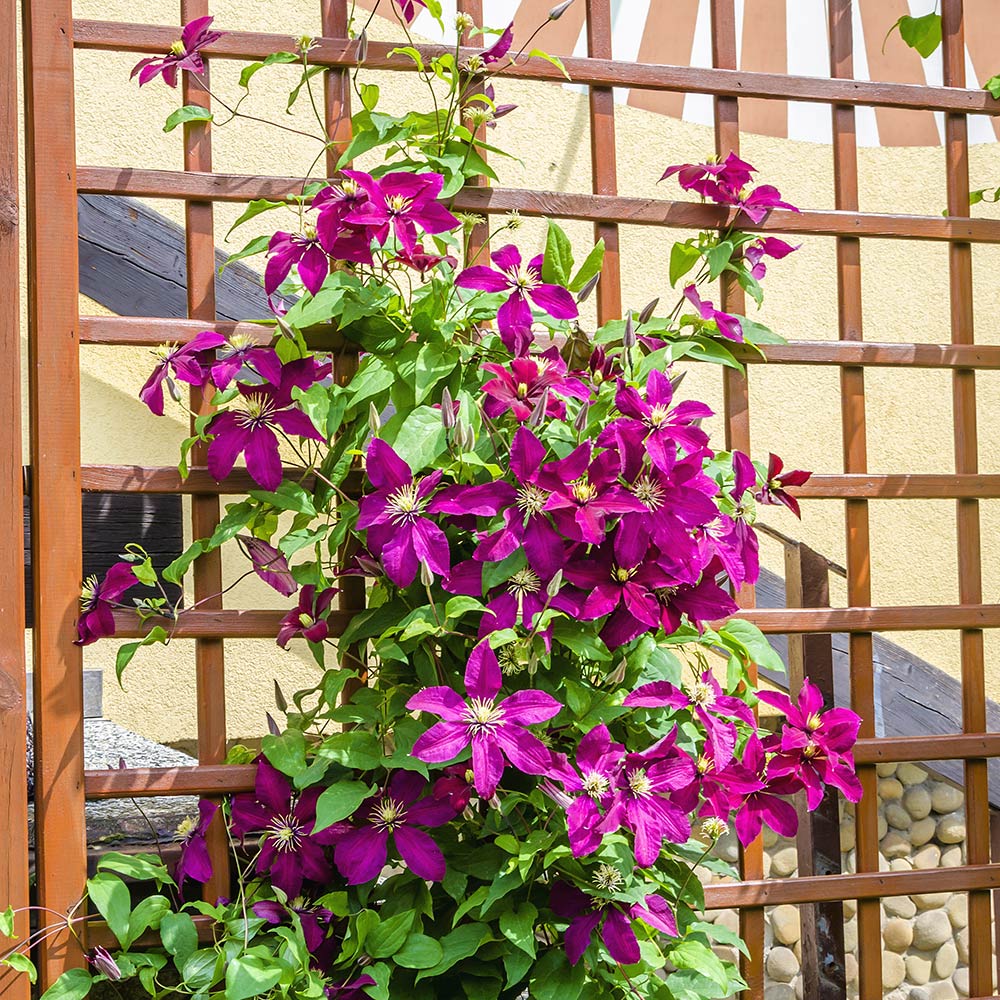

Decorating your garden’s vertical spaces with vibrant and lively colors is a breeze with flowering vines. Whether you opt for annual vines that offer quick color for a single growing season or go for the long haul with perennial vines that will grow and bloom for years on end, both types can be grown to perfection in places where they have ample room to climb and flourish – think fences, arbors, trellises, and more! To get started, consider the ever-popular morning glory.

Morning glory is a rapidly growing flowering vine that effortlessly climbs trellises, railings, and other types of supports. It comes in an extensive range of colors and bi-colors, making it a no-fuss annual to cultivate. This plant gets its name from its 4- to 6-inch-wide flowers that bloom early in the day and close up by afternoon. While morning glory can be quite invasive in self-sowing, it’s easy to eliminate unwanted seedlings. Its season of bloom ranges from summer to fall, and it thrives in moist, well-drained soil under full sun conditions. This vine can grow as tall as 10 feet.

Type: Annual
Number 2 out of 15 – Black-Eyed Susan Vine
The Black-Eyed Susan Vine is another rapidly growing annual that produces a plethora of vibrant yellow, orange, or white flowers with dark centers throughout the summer season. You may opt to grow this vine from seed and plant it directly in your garden or purchase seeded plants. While this climbing vine thrives on a trellis, it’s also popular for hanging baskets where it can wrap around the basket supports.
It prefers full sun to partial shade and thrives in moist, well-drained soil.

With a maximum height of 8 feet and suitable for zones 10-11, the clematis is a stunning plant that comes in various colors and shapes, including double and single flowers. It’s perfect for climbing up mailboxes, arbors, or fences. If you’re short on space, you can opt for the dwarf clematis that only grows to about 3 feet tall, which is ideal for containers. Clematis vines are not difficult to grow as long as you follow the old adage that they love “heads in the sun and feet in the shade.” It’s best to plant them in full sunlight but ensure that their roots remain cool and shaded by applying a thick layer of mulch around them. Some clematis plants blossom on new wood, while others prefer old wood. Therefore, it’s preferable to trim them during spring when new growth starts, avoiding accidentally cutting off flower buds, regardless of the type of clematis you have.

During summertime, the Carolina jessamine is a beloved perennial that flourishes in Zones 4-8. In mild winter areas, it can bloom as early as February. The striking trumpet-shaped, fragrant flowers are a brilliant golden yellow that illuminates the garden when few other plants are in bloom. If left unpruned with sufficient support, this fast-growing vine can tower to impressive heights. It’s an excellent choice for adding a pop of color to a woodland garden or screening a view. In early spring, the Carolina jessamine reaches its peak bloom period.


Ideal Growing Environment: It is recommended to grow this plant in an area that receives ample sunlight and where the soil is moist and well-drained. This promotes healthy growth and development of the plant.
Expected Size: This plant species can grow up to 20 feet tall, so it is best to provide enough space for it to reach its full potential.
Suitable Zones: The plant is best suited for regions with a climate that falls within zones 7-10. It thrives in these conditions and can adapt well to the environment.

During the springtime, the Deep South is filled with the alluring fragrance of Madagascar jasmine. This sophisticated flowering perennial vine features deep green, tough leaves that bear clusters of sweet-smelling, trumpet-shaped white flowers. Although it’s commonly used as a patio plant in the north, it can tolerate cold winters if kept in a cool indoor location. This plant requires minimal maintenance and care.
The seasonal blooming hyacinth bean vine is a fast-growing, stunning vine that stretches towards the sun. Its gorgeous green or purple foliage adorned with vibrant pink and purple flowers creates a vibrant canopy over trellises and arbors. Once the blossoms fade, large glossy purple seed heads resembling pea pods adorn the ends of each branch. It should be noted, however, that raw hyacinth beans are toxic, so this vine is best used as an ornamental plant.
The Passion Vine is another beautiful vine that thrives in the Deep South. This plant features intricate, exotic, and colorful blooms that add a touch of elegance to any garden or patio. These vines are also low maintenance and can be grown indoors or outdoors.

One way to show your support for pollinators is by planting passion vine in your garden. This vine serves as a host and nectar plant for butterfly species like gulf fritillary and zebra longWing, while also providing nectar for other species. Not only is passion vine beneficial for pollinators, it also boasts beautiful flowers that gardeners can appreciate. The petals feature a lovely combination of white and purple hues, with a darker purple crown and yellow center.
:strip_icc()/red-mandevilla-vine-858f26ed-11caa644771a4714a6deafad3022cbe1.jpg)
Blue sky vine is a showy relative of the black-eyed Susan vine, boasting numerous large, cup-shaped flowers in a striking shade of purplish-blue with golden centers. Known by its other name, Bengal clock vine, this vine grows quickly and is typically perennial in milder climates. However, it can also be cultivated indoors as a houseplant during the winter in colder regions. As an annual, blue sky vine can reach heights of up to 8 feet within a single season.
:max_bytes(150000):strip_icc()/climbing-plants-fences-pergolas-clematis-getty-0823-a33a6777d39647568af7937444717b90.jpg)
If you’re someone who wants to cover a large area like a fence or pergola quickly, then trumpet vine is the perfect choice for you. This vine is quite vigorous and has beautiful, finely divided foliage that is adorned with funnel-shaped flowers in shades of orange, red, or yellow during midsummer. However, you should keep in mind that this woody vine can become quite heavy over time. Therefore, it’s essential to grow it on stable support that can withstand the weight of the vine.

Wisteria is not only visually appealing but also has a pleasant fragrance, making it a great addition to larger structures like arbors, porches, or pergolas. It can also be trained to grow in tree form, showcasing its abundant crop of white, purple, or lilac blooms in the early spring. Make sure to choose the native species, Wisteria frutescens, which thrives in full sun and well-drained soil, and can grow up to 30 feet tall in Zones 5-9.
Cypress vine, similar to morning glory, is an annual flowering vine that grows quickly and adds color to a summer garden. With its ferny, light green foliage and scarlet, trumpet-shaped flowers, it’s also known as the hummingbird vine. Cypress vine self-seeds, but excess seedlings are easy to remove. It grows up to 15 feet tall in full sun and moist, well-drained soil as an annual plant.
Mandevilla is a heat-tolerant vine that can bring a tropical touch to your patio or porch. It comes in single and double white, red, pink, and red-and-white flowers and thrives in hot weather. It makes a top-rated container plant, growing on a low trellis or pyramid. This low-maintenance climbing plant can brighten your porch, patio, deck, or balcony and can grow up to 10 feet tall in Zones 10-11.
Honeysuckle vine, with its long, tubular flowers, has a sweet fragrance that attracts hummingbirds. Although it looks tropical, it prefers a northern climate and is available in various species. Its yellow, white, orange, or red flowers bloom in the spring and can climb up sturdy posts, fences, or trellises. Honeysuckle vines are easy to care for and prefer full sun and medium moisture, well-drained soil.
Climbing nasturtiums have edible funnel-shaped flowers in vibrant shades of yellow, orange, peach, or red and are sun-loving annual plants. Their round leaves are also edible, with a peppery flavor. Initially, you may need to tie this plant to a low fence or trellis for climbing support, but once it grows, you’ll be rewarded with masses of jewel-tone flowers. Climbing nasturtiums grow up to 10 feet tall as annuals, thriving in full sun and slightly acidic, well-drained soil.
Climbing roses can grow long canes that adapt to training on pillars, fences, arbors, and gazebos. These acrobatic climbers are usually mutations or variations of bush-type varieties and bloom once or continuously, depending on the type. Regular deadheading of the flowers can encourage continuous blooms throughout the growing season. Pruning your roses in winter before the initial bloom can increase the number of blooms later on. Climbing roses prefer full sun and moist, well-drained soil and can grow up to 10 feet tall in Zones 5-9.


